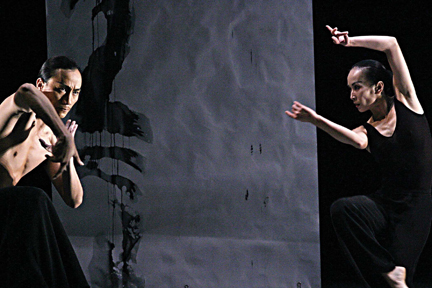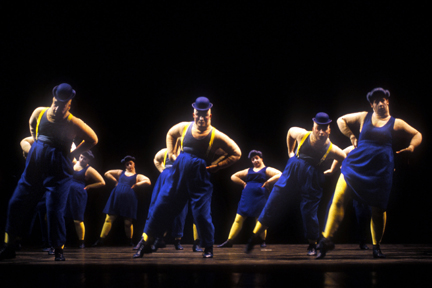San Francisco Letter 17
Cloud Gate Theater
Wild Cursive
Cal Performances, Zellerbach Hall
October 21, 2006
Lyon Opera Ballet
Cal Performances, Zellerbach Hall
October 27, 2006
by Rita Felciano
copyright 2006 by Rita Felciano
 When watching dance, a score’s connection to the piece often gets shortchanged. Maybe because we are better trained to take in information visually, we turn out aural cues in order to focus on what our experience tells us is the important task at hand. Ideally, visual and sound blend, or at least feed off each other but the relationship between the two arts is not always easily decipherable.
When watching dance, a score’s connection to the piece often gets shortchanged. Maybe because we are better trained to take in information visually, we turn out aural cues in order to focus on what our experience tells us is the important task at hand. Ideally, visual and sound blend, or at least feed off each other but the relationship between the two arts is not always easily decipherable.
If the music is familiar, additional issues crop up. You have to adjust your concept to the choreographer’s. That can be exciting because she might have heard something you didn’t. But you also may have to fight your own perceptions particularly if you have strong feelings about a piece of music. A few years ago I remember being incensed at how a local choreographer had “abused” a Bach cello sonata. “How dare he……,” kept cursing through my head even as I attempted to see what on earth had compelled him to use the Bach. Of course, in my indignation, I failed to remember that great art is pretty sturdy and can withstand all manner of treatment.
Two recent concerts served as reminders on just how satisfying the relationship between sound and sight can be.
At Cloud Gate Dance Theater’s “Wild Cursive”, I kept thinking of two elderly gentlemen bent over a display case at a Chinese calligraphy show a few years ago. I couldn’t understand them but they clearly were discussing, rather heatedly, a single ideogram, one out of the hundreds that must have been in that exhibit. If I understood their hand language correctly, they were disagreeing about how the brush stroke on what looked like a little “tail” was or should have been done. They seemed more interested in the act of writing than in the result.
Writing in space is what Hin Hwai-min’s dancers do superbly. Whether they place an extended leg just so, abruptly shift direction or melt frozen stances into liquid descents, the dancers are the brushes in these whirling, boiling designs. Yet the turbulence is balanced by moments of astonishing stillness. While the integration of Western dance—a lot of Graham—and martial and Chinese circus arts was impressive—it was ever so smooth and natural—more intriguing was the way the choreographer used these wildly active bodies.
“Cursive” doesn’t seem to have a trajectory though it was not entirely static either. In the latter episodes the dancers appeared to respond to each other, albeit fleetingly and discretely. A leap might have been provoked by some one’s stomp. Was it this dancer’s kick that sent that one off stage? A pas deux—a little more than just two dancers on stage—suggested the possibility of connection. Yet for the most part, “Cursive” simply placed one section next to the other.
Using dancers as elements in an action painting of dance in my eyes dehumanized them. Their stark black costumes, severe hair dos and the common dance language didn’t help. They were engaged in a common, but not communal enterprise. Jim Shum and Liang Chun-mei’s music seemed to countermand that notion and created a desire balance.
The piece started in silence. When the sound came in, it was fragmentary, consisting of bit and. Most of it was derived from found material; bringing natural life into the high artifice of the stage: wind, rustling leaves, waves, a thunderclap, water dropping, birds chirping. But there also were man-made signals: metallic clashes, scrapings, gongs. These sonic comments suggested a tangible, chaotic reality And then—just as the dancers began to almost connect with each other—some of them joined that bit of life-like reality. They shouted. They became individuals.
When Cloud Gate brought “Moon Water” to Berkeley three years ago, I remained very conflicted. I didn’t much like the use of the excerpted Bach cello suites but the lighting scheme and the mirrors also took me aback. Despite its impressive dancers, the piece had something jejune about it. It was uncomfortably “pretty.” “Cursive” has more of a backbone, in part, because of the way it uses music.
From looking at its repertoire, Lyon Opera Ballet doesn’t much look like a ballet company. These are ballet-trained dancers but then so are most performers of today’s contemporary dance ensembles. There is nary a ballet step or attitude in sight in the three works by Anna Teresa de Keersmaeker (“Die Grosse Fuge”), Sasha Waltz (“Fantasie”) and Maguy Marin (“Groosland”). Yet by programming—and in the case of Waltz commissioning—the pieces, Yorgos Loukos plugged into another noble ballet tradition, the close relationship between dance and music.
 The choreographers chose major pieces of Western concert music and opened unexpected perspectives that made musical as well as choreographic sense. The Lyon Opera Ballet’s became a triple bill of uncommon satisfaction.
The choreographers chose major pieces of Western concert music and opened unexpected perspectives that made musical as well as choreographic sense. The Lyon Opera Ballet’s became a triple bill of uncommon satisfaction.
The amplified version of Beethoven’s Die Grosse Fuge, Op.133 that de Keersmaeker used for her stunning octet (seven men, one woman) sounded more like a string orchestra than just a quartet. It’s a forbidding piece of music with writing so dense that it dared us to penetrate its penumbral textures. Maybe that’s why so often the dancers seemed to wait to see what would descend onto them next. De Keersmaeker didn’t necessarily make the music more accessible but she opened ears. At one point in a slow soft melody I thought I heard a dance-like motif deep inside the score. That’s when some of the men took off their coats and rolled up their sleeves. Sometimes the music seemed to actually call up specific physical responses. Forceful percussive down strokes sent the men into jumps as if off a hot griddle. A slow crescendo raised arms on the diagonal from prone bodies. Fists shot up in response to some of those extraordinary dissonances. But throughout de Keersmaeker’s exhilarating response to this mountain to be scaled came in terms of thrillingly athletic and balletically precise calibrations. These were guys—elegant guys- at work. And at play.
German romanticism (as distinguished from English romanticism) was once summarized to me in the person of the wanderer, the aimless, restless explorer. Schubert’s Fantasie in F minor has that meandering yet emotionally satisfying quality to it. When Waltz sent her eight dancers into running patterns in the long center section of her gorgeously enigmatic “Fantasie,” they looked like rushing wind or kids pretending to be birds or airplanes. Yet these images of absolute freedom had their feet propelled by very exacting piano notes. And if a running step happened to end in an arabesque, the person behind will scooted underneath without missing a beat. End up jogging backwards? No problem. Open arms were waiting.
The fanciful “Fantasie” started out as a shadow play of two pretend murders. But this very concrete image evaporated into madcap chases, changing of partners and identities, wisps of quasi narratives floating about like flecks of sunlight. Two very disparate pas de deux—in one of them the woman hung upside down—were placed far apart on stage. Which one did Waltz want us to watch. A mysterious girl in blue—evanescent like a butterfly—was courted and lost and courted again. “Fantasie” was just a wanderer’s midsummer night’s dream.
Marin set her touch-your-heart “Groosland”, which was seen in Berkeley before, on Bach’s Brandenburg Concertos No. 2 and 3. And what a choice. Among the most popular of Bach’s music, their appeal is so widespread to certainly include the ordinary Joes and Janes whose dignity is at the core of so much of Marin’s choreography. Baroque music is dance music, and did those wonderfully clumsy human puppets ever dance: dainty pas de chats from fat little legs, low to the ground but perfectly symmetrical jetés, single pirouettes that needed that additional push to finish.
Marin’s genius let her hone in on the glory and exuberance of the Bach; but she also heard the music’s more “pedestrian” side. The music runs on like a well-oiled machine. After a while, to contemporary ears at least, the simplicity of those clock rhythms began to numb the ear. You longed for irregularity, a missed beat or two or some sort of syncopation. No wonder those dancers hopped around like puppets.
Photos:
First, Cloud Gate Dance Theatre. Photo courtesy Cal Performances.
Second, Lyon Opera Ballet. Photo by Michel Cavalca.
Volume 4, No. 39
November 6, 2006
copyright ©2006 Rita Felciano
www.danceviewtimes.com